
Background information
Old smartphone hardware with Android 13: my custom ROM journey
by Martin Jud

Until recently, I’d been carrying around a real brick. Now, I’ve switched to an ultra-small, very affordable smartphone that I mostly love. It’s not perfect – but it’s the perfect size. Or is it?
For the past few years, my trusty companion has been a clunky Caterpillar smartphone, for which I was often ridiculed. My new device also attracts attention, but for exactly the opposite reason: the KingKong Mini 2 Pro from Cubot has a four-inch, 2:1 display and measures just twelve centimetres in length. Why did I make the switch? I want to find out where my personal sweet spot is in terms of size.
Now, a smartphone with a three- or three-and-a-half-inch display is too small even for me. That’s why I’m starting at four inches. Find out how I like it in this article. But that’s not the end of my journey. Since this Cubot smartphone comes with the outdated Android 11, I’ll be updating it manually to the latest Android 13. Stay tuned for an article on that.
I used to have a small phone, and I want one again. The idea came to me as I was reminiscing about my Sony Ericsson W880i from 2007. Back then, before smartphones existed, cell phones were even more wieldy.
The Walkman phone had dimensions no smartphone can match today. I could slip it into my pants pocket and would barely notice I was carrying it. It was only 10.3 centimetres long and not even half a centimetre thick. Moreover, it weighed just 71 grammes. I loved the thing.
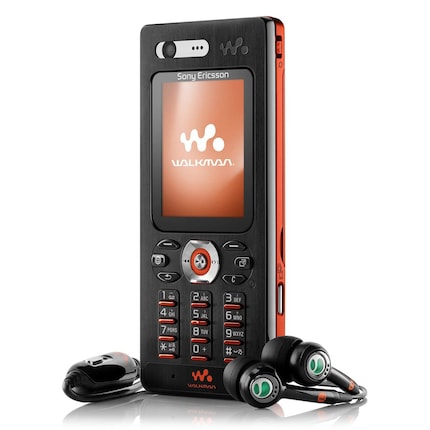
Fast forward sixteen years. Very small smartphones are a rare specimen. There are hardly any mid- and upper-range devices below six inches. The smallest models include the Asus Zenfone 9 (5.92 inches) and the Samsung Galaxy S23 (6.1 inches). No matter. I use my smartphone primarily for surfing, chatting, making phone calls and online shopping, entry-level hardware will do.
So, I ordered an inexpensive – almost cheap, really – smartphone from China for 96 francs, including shipping. Cubot’s smartphones are actually also available for purchase in Europe, but at ridiculously high prices. I’m frankly not prepared to pay a 100 or 200 per cent or even higher mark-up. Importers in Europe make a mint of money at the expense of uninformed customers. By the way, we do also offer overpriced Cubot phones in our shop – mind you, they’re supplied by a third-party vendor.
On my new four-inch baby phone, I deliberately forgo features like a great camera or a UHD display. Even with its resolution of 1080 × 540, the KingKong has over 300 pixels per inch (ppi), resulting in a sharp image. Thanks to 450 nits peak brightness, it remains legible even in sunny weather. But, most importantly, it’s more wieldy than anything I’ve had in a long time.
Here’s my new phone compared to the old one:
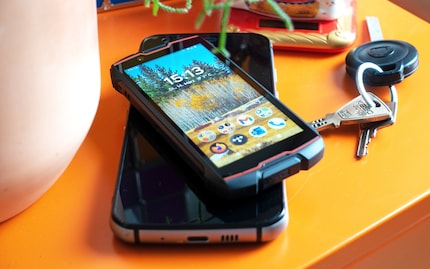
The Cubot KingKong Mini 2 Pro is so small that I started looking for it before realising it was in the pocket of my hoodie. Underneath it is my Caterpillar CAT S62 Pro with an integrated thermal imaging camera. At the time, I’d bought it precisely because of this camera, which has since started malfunctioning. It’s extremely heavy for a 5.7-inch smartphone, tipping the scales at 248 grammes. It can easily escape your grasp when trying to send a message one-handed. But hey, at least it survives any fall thanks to its rugged design.
With the KingKong, which is also rugged, I only hold 123 grammes in my hand. It feels wonderful. But what I’m most curious about is if the keyboard will be usable in portrait mode, given the screen’s width of 4.5 centimetres.
Even on paper, my new phone has quite a few drawbacks. But I think I can get over them. Here are my personal pros, cons, and neutral points:
The pros:
The cons:
The neutral points:
By the way, I almost bought the KingKong Mini 3 instead, as it has a faster processor. However, the display was a deal-breaker for me; with a diagonal of 4.5 inches and 1170 × 480 pixels, it’s narrower but longer. As a result, the KingKong Mini 2 Pro offers two millimetres of extra width in portrait orientation, despite its smaller diagonal. And its pixel density is higher by 21 ppi.
Out of the box, Cubot offers a great, if somewhat outdated, Android experience. The good thing about Android 11 is that it comes without an extra customised interface and annoying third-party apps like TikTok, Instagram or Twitter. Only the Google apps are preinstalled.
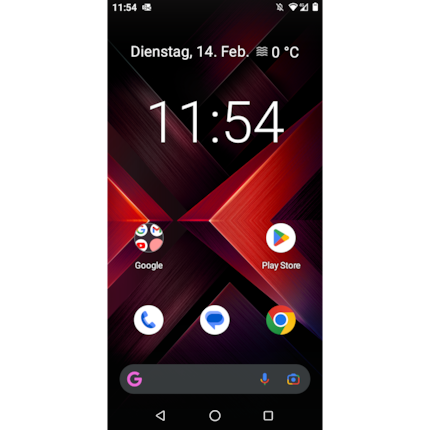
Google Play Store is available, and I can reinstall my purchased apps after logging in. Google Maps works, as do all the Google services I need.
My new smartphone is delightfully tiny, and its display is indeed beautifully bright and sharp. Although transferring my apps and settings takes rather long, they all work great once installed. My favourite Android interface, Smart Launcher 6, also runs smoothly. Only the Digitec and Galaxus apps are very slow. I have to wait for images to load, and scrolling tends to be quite choppy. This doesn’t happen to the same extent in the Chrome browser, which I can also use to shop on Digitec and Galaxus. Other store apps, such as eBay or Aliexpress, work without issue.
What I do notice, however, is that opening websites with a lot of content in the browser causes scrolling to stall until the entire website is loaded. Loading times are rather sluggish compared to other phones, including my Cat. Still, it never takes longer than a few seconds. The operating system itself works swiftly, as does swiping from one home screen to the next. Only when opening apps do I notice that they sometimes take a bit longer to launch.
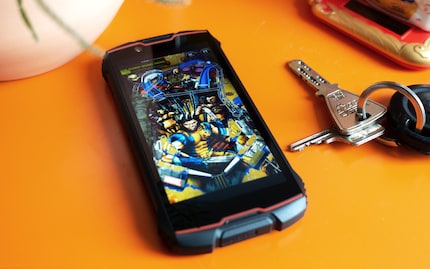
I rarely ever use my phone for gaming. But I do find myself enjoying a round of Zen Pinball on the Cubot. What’s probably the smallest Marvel table I’ve ever played on runs smoothly and packs a punch. But the performance of the 2018 processor isn’t enough for much more than that. Geekbench 6 gives it 591 points in the multi-core test and 170 points in the single-core test. For comparison, the Samsung Galaxy S23 scores 5,193 in multi-core and 1,986 in single-core.
What I immediately dislike about the new smartphone is the screen protector. The fact that Cubot’s stuck one on is a good thing. However, at high brightness, the image looks a bit milky with a white background. The protector’s also a serious fingerprint magnet, and I can make out scratches after just two weeks. They’re mostly located where I swipe up and down with my thumbs. I guess my thumbnail often brushes against the film.
Because it looks ugly, I opt to remove the ex-factory film after week four, taking care not to damage the display. I’ve already ordered a tempered glass screen protector with an oleophobic coating, which should arrive soon.
When I use my phone in landscape mode, I hit every key. In portrait orientation, this proves to be a skill that requires practice. Even though I have rather dainty hands for a man, I keep accidentally pressing the wrong letter.
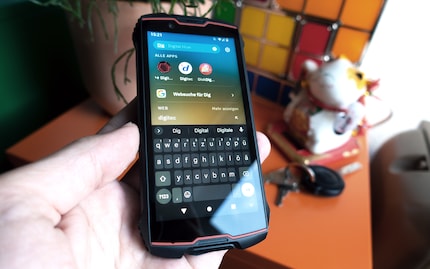
Luckily, I’m quite stubborn, so I resolve to practise typing. After a week, I only mistype about every tenth word. After four weeks, I’ve finally got the hang of it. At most, I’ll have one or two typos per day, which are no more than cause for a chuckle. In contrast, just seven days ago, it wasn’t uncommon for me to start swearing.
In good lighting, the camera delivers okay-quality pictures. In other cases, not so much. But the two cameras are enough for me; for photos I want to turn out nice, I use a Sony Cyber-shot DSC RX100.
The battery lasts me a day with normal use. On days filled with more phone calls or extensive pinball sessions, I end up with a single-digit battery percentage by evening.
Something I had to get used to was the font size in the browser, which I increased. On the itty-bitty display, this makes blocks of text look a bit longer than they are.
Four inches is close to my sweet spot – and I like the 2:1 format. But a tad more screen surface area would be nice. I’m happy with the overall size of the phone. So, a device of the same size with smaller bezels would be perfect. Come to think of it, it could also be a bit thinner.
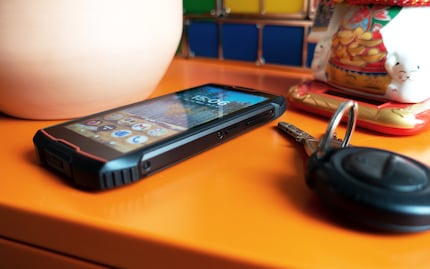
All in all, I’m happy with my new KingKong. I’ll continue using it for now. But I’ll soon say my goodbyes to the preinstalled Android 11. As soon as I manage to get Android 13 running stably on my phone, I’ll report back to you in another article. Using an alternative ROM will allow me to do away with certain Google apps, which will hopefully extend the battery life. I’m also going to root my phone to install certain apps requiring special admin rights.
Header image: Martin Jud
I find my muse in everything. When I don’t, I draw inspiration from daydreaming. After all, if you dream, you don’t sleep through life.
Interesting facts about products, behind-the-scenes looks at manufacturers and deep-dives on interesting people.
Show all